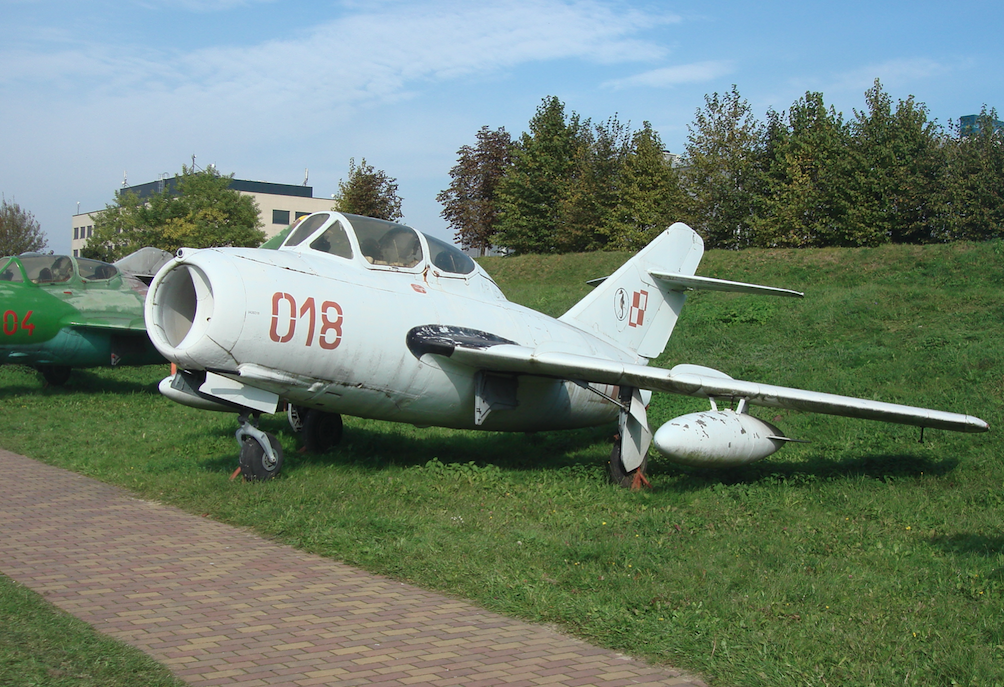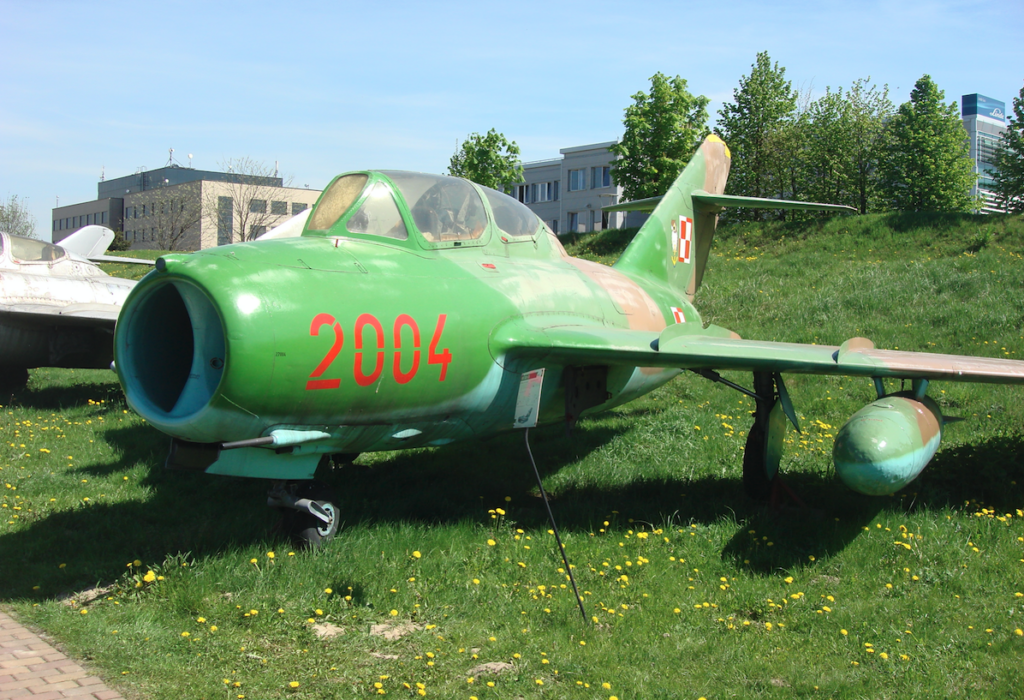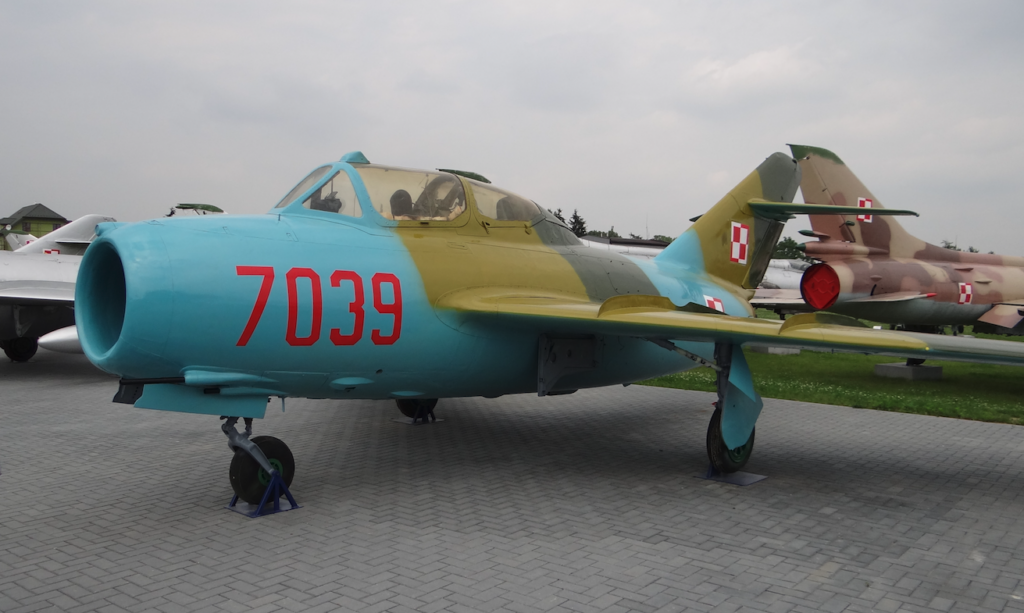Kraków 2007-03-20
153b Section 1958-01-01
OKB Mikojan MiG-15 UTI 1953-01-23
LZR Bydgoszcz SB Lim-1/2 1958-01-01
Poland




History MiG-15 UTI
At the end of July, probably on July 30, 1951, the first 4 MiG-15 UTI trainers landed at the Warsaw Bemowo airport, and their numbers were; 104-11, 104-23, 104-24, 104-25. By the end of 1952, we received about 20 MiG-15 UTIs from CCCP. We also received several aircraft from Czechoslovakia. Initially, these aircraft were placed in regiments equipped with MiG-15s, but later they were gathered at the training base in Krzesiny, in the 62nd Fighter Training Regiment.
The MiG-15 UTIs, together with single-seat MiG-15s, were sent to OSL-5 (Officer’s Aviation School) in Radom in 1954. The MiG-15 UTI aircraft were delivered to OSL-4 in Dęblin only in 1955.
In connection with the commencement of serial production of the Lim-1 and then Lim-2 aircraft in huge quantities, it turned out to be necessary to acquire a larger number of dual-rotor aircraft.
SB Lim-1. 1958
Around 1956, it turned out that new MiG-17 fighters equipped with SR would soon enter the Polish Military Aviation, thanks to which they would be able to operate in almost any weather conditions. Therefore, it was necessary to slowly withdraw Lim-1 fighters from fighter regiments, which remained in service until the end of 50 years. This led to further actions. Due to the very small number of MiG-15 UTI training twins, an opportunity arose to modify Lim-1 aircraft to SB Lim-1.
Since the WSK PZL-Mielec production plant did not have the possibility to perform these modifications at the appropriate time, it was decided to entrust this task to LZR (Air Repair Plants) in Bydgoszcz. All Polish two-seater Lim aircraft were created in LZR in Bydgoszcz, by modifying the already existing single-seater Lim-1 and Lim-2 aircraft. Polish two-seaters differed significantly from Soviet ones. The radio-electronic equipment and armament were different. The modifications were made according to the rationalization projects of the technical staff of the Air Force. Therefore, the design was also different.
It was possible that two-seater aircraft were built from two different machines. For example, the front part from Lim-1 and the rear part from Lim-2. This situation makes it very difficult to present a fairly reliable list of aircraft in service. From 1958 to 1960, at least 100 machines were reported as converted to SB Lim-1.
SB Lim-2. 1960
At the beginning of the 1960s, the Lim-2 fighters began to undergo conversion to dual-rotor. The aircraft received the designation SB Lim-2. About 200 units underwent conversion.
SB Lim-1 A (1965) / 2 A (1968).
From 1958, the remaining Lim-1/2 aircraft were transferred to fighter-attack aviation units. They had to be adapted to support, reconnaissance and artillery fire control. SB Lim-1 and SB Lim-2 aircraft began to be rebuilt into the so-called Artillery designated SB Lim-1 A, (from 1965) and SB Lim-2 A. (from 1968). Initially, they bore the designation instead of the letter A, the abbreviation Art. The conversion was carried out at LZR (Air Repair Plants) in Bydgoszcz.
In order to adapt the aircraft to new tasks, the controls were removed from the second cabin and a navigator’s desk was installed. The armament was increased to 2 NR-23 cannons. On some aircraft, a camera was mounted under the middle part of the fuselage, as well as a periscope for the pilot. To increase the range, the additional tanks with a capacity of 2 x 400 liters were replaced with tanks of 2 x 600 liters. The crew consists of a pilot and a navigator. There were no controls in the navigator’s cabin. However, the equipment necessary to perform the tasks was installed. Lim-1 A was equipped with an AFA-21 camera, while Lim-2 A, in addition to the AFA-21 camera, received a second AFA-39.
Lim-2 A aircraft received characteristic painting in protective colors, the so-called two- or three-color camouflage.
The last SB Lim-1 units were withdrawn from service in 1975, while SB Lim-2s continued to fly after 2000.
SB Lim-2 M.
A dozen or so SB Lim-2 A aircraft underwent another transformation. Secondary controls were reinstalled and modernization was carried out. The new aircraft were designated SB Lim-2 M. They served in the army until the early years of the 21st century. The aircraft were mainly used as training and reconnaissance aircraft.
Written by Karol Placha Hetman
